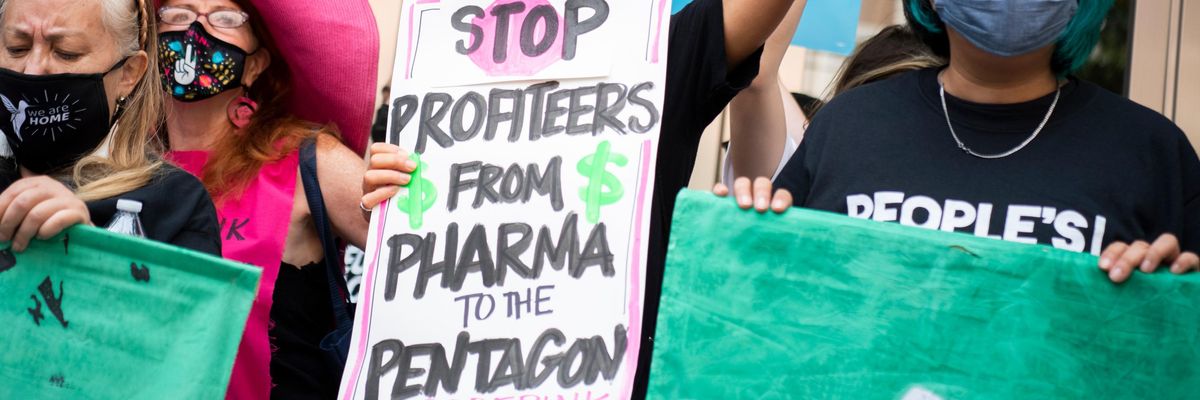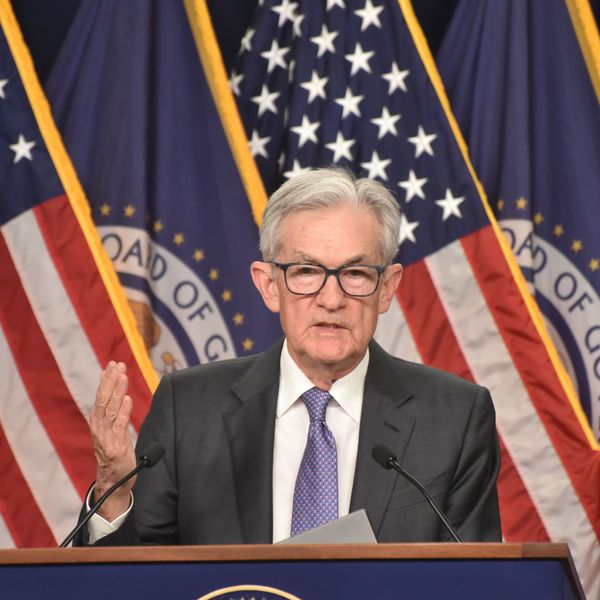
Interest Rate Hikes Won’t Solve the Affordability Crisis
Manipulating rates can’t make life more affordable for struggling families—but public investment and sound regulations that rein in corporate price-gouging can.
For the last two years, the debate on the economy has centered around inflation.
After reaching a 40-year high last summer, inflation as measured by economists is now approaching normal levels. But despite the rapid slowdown, millions still feel squeezed by a decades-long affordability crisis.
Even before the Covid-19 pandemic, Americans struggled to afford sky-high prices for homes, child care, college, and healthcare, as wages lagged far behind the rising cost of living. Treating all this as “inflation” does more harm than good.
Congress and statehouses must be in the driver’s seat of the affordability agenda, as only these democratic institutions can fund long-overdue investments in child care, healthcare, housing, and education.
In conventional economic theory, inflation is a “demand side” problem—a polite way for economists to say people have too much money. Too much money chasing too few goods, the theory goes, leads to higher prices.
It’s hard to look around this country and conclude that our main economic challenge is people having too much money. Seventy percent of Americans report feeling “financially stressed,” and nearly a third report having paid a late bill in the last six months.
But there are other drivers of high prices that rarely make it into our conversation about inflation.
We know, for example, that homes are getting more expensive because there aren’t enough homes being built. We also know that decades of corporate consolidation in certain industries has led to less competition and higher prices. The solutions to these cost barriers are relatively obvious: Build more homes and enforce antitrust laws.
But instead, for the last year and a half, we’ve largely looked to the Federal Reserve to lead our response to high prices. Unfortunately, the Fed wields one tool to deal with inflation: interest rate hikes. And they work more like a sledgehammer than a scalpel.
Since May 2022, the Fed has aggressively raised interest rates to slow the economy by making it more expensive to borrow money. When businesses can’t borrow, the story goes, they’re less likely to expand operations and hire people—and when families can’t borrow, they buy less. This leads to layoffs and lower wages, ensuring that workers have less money to spend “chasing goods.”
The Fed sees higher unemployment, which can be catastrophic for already struggling families, as a positive sign that these rate hikes are working.
There are at least two major issues with the Fed’s theory. First, inflation is coming down, our economy is growing, and unemployment is near record lows. As it turns out, you don’t have to grind the economy to a halt and sacrifice millions of jobs to slow down inflation.
More importantly, these rate hikes fail to address the core drivers of rising prices today—and in many cases make the problem worse. The Fed can’t build more homes, break up price-gouging corporate monopolies, or lower the cost of prescription drugs. But it can make life even more expensive.
We see this clearly in the housing market. Very few people are eager to buy a home at 7% interest, and still fewer want to sell homes that they’re financing at 3 or 4%. These high rates push more people to rent, which drives up the cost of rent, and discourages the construction of new homes.
To address the true drivers of higher prices, we must bring the concept of inflation back down to Earth. Manipulating interest rates can’t make life more affordable for struggling families—but public investment and sound regulations that rein in corporate price-gouging can.
Congress and statehouses must be in the driver’s seat of the affordability agenda, as only these democratic institutions can fund long-overdue investments in child care, healthcare, housing, and education. These investments are the seeds of a stronger, more inclusive economy.
Deferring responsibility for this future to the Fed is a colossal mistake.
An Urgent Message From Our Co-Founder
Dear Common Dreams reader, The U.S. is on a fast track to authoritarianism like nothing I've ever seen. Meanwhile, corporate news outlets are utterly capitulating to Trump, twisting their coverage to avoid drawing his ire while lining up to stuff cash in his pockets. That's why I believe that Common Dreams is doing the best and most consequential reporting that we've ever done. Our small but mighty team is a progressive reporting powerhouse, covering the news every day that the corporate media never will. Our mission has always been simple: To inform. To inspire. And to ignite change for the common good. Now here's the key piece that I want all our readers to understand: None of this would be possible without your financial support. That's not just some fundraising cliche. It's the absolute and literal truth. We don't accept corporate advertising and never will. We don't have a paywall because we don't think people should be blocked from critical news based on their ability to pay. Everything we do is funded by the donations of readers like you. Will you donate now to help power the nonprofit, independent reporting of Common Dreams? Thank you for being a vital member of our community. Together, we can keep independent journalism alive when it’s needed most. - Craig Brown, Co-founder |
For the last two years, the debate on the economy has centered around inflation.
After reaching a 40-year high last summer, inflation as measured by economists is now approaching normal levels. But despite the rapid slowdown, millions still feel squeezed by a decades-long affordability crisis.
Even before the Covid-19 pandemic, Americans struggled to afford sky-high prices for homes, child care, college, and healthcare, as wages lagged far behind the rising cost of living. Treating all this as “inflation” does more harm than good.
Congress and statehouses must be in the driver’s seat of the affordability agenda, as only these democratic institutions can fund long-overdue investments in child care, healthcare, housing, and education.
In conventional economic theory, inflation is a “demand side” problem—a polite way for economists to say people have too much money. Too much money chasing too few goods, the theory goes, leads to higher prices.
It’s hard to look around this country and conclude that our main economic challenge is people having too much money. Seventy percent of Americans report feeling “financially stressed,” and nearly a third report having paid a late bill in the last six months.
But there are other drivers of high prices that rarely make it into our conversation about inflation.
We know, for example, that homes are getting more expensive because there aren’t enough homes being built. We also know that decades of corporate consolidation in certain industries has led to less competition and higher prices. The solutions to these cost barriers are relatively obvious: Build more homes and enforce antitrust laws.
But instead, for the last year and a half, we’ve largely looked to the Federal Reserve to lead our response to high prices. Unfortunately, the Fed wields one tool to deal with inflation: interest rate hikes. And they work more like a sledgehammer than a scalpel.
Since May 2022, the Fed has aggressively raised interest rates to slow the economy by making it more expensive to borrow money. When businesses can’t borrow, the story goes, they’re less likely to expand operations and hire people—and when families can’t borrow, they buy less. This leads to layoffs and lower wages, ensuring that workers have less money to spend “chasing goods.”
The Fed sees higher unemployment, which can be catastrophic for already struggling families, as a positive sign that these rate hikes are working.
There are at least two major issues with the Fed’s theory. First, inflation is coming down, our economy is growing, and unemployment is near record lows. As it turns out, you don’t have to grind the economy to a halt and sacrifice millions of jobs to slow down inflation.
More importantly, these rate hikes fail to address the core drivers of rising prices today—and in many cases make the problem worse. The Fed can’t build more homes, break up price-gouging corporate monopolies, or lower the cost of prescription drugs. But it can make life even more expensive.
We see this clearly in the housing market. Very few people are eager to buy a home at 7% interest, and still fewer want to sell homes that they’re financing at 3 or 4%. These high rates push more people to rent, which drives up the cost of rent, and discourages the construction of new homes.
To address the true drivers of higher prices, we must bring the concept of inflation back down to Earth. Manipulating interest rates can’t make life more affordable for struggling families—but public investment and sound regulations that rein in corporate price-gouging can.
Congress and statehouses must be in the driver’s seat of the affordability agenda, as only these democratic institutions can fund long-overdue investments in child care, healthcare, housing, and education. These investments are the seeds of a stronger, more inclusive economy.
Deferring responsibility for this future to the Fed is a colossal mistake.
- 'Illegal Corporate Price-Fixing' Is Rampant in US Economy: Report ›
- 'Rent Is Too Damn High': Biden Pressured to Act as Housing Costs Fuel Inflation ›
- Merkley Bill Aims to Dismantle Hedge Fund Stranglehold on Housing Market ›
- Largest US Corporate Landlords Reap Huge Profits Amid Double-Digit Rent Hikes ›
For the last two years, the debate on the economy has centered around inflation.
After reaching a 40-year high last summer, inflation as measured by economists is now approaching normal levels. But despite the rapid slowdown, millions still feel squeezed by a decades-long affordability crisis.
Even before the Covid-19 pandemic, Americans struggled to afford sky-high prices for homes, child care, college, and healthcare, as wages lagged far behind the rising cost of living. Treating all this as “inflation” does more harm than good.
Congress and statehouses must be in the driver’s seat of the affordability agenda, as only these democratic institutions can fund long-overdue investments in child care, healthcare, housing, and education.
In conventional economic theory, inflation is a “demand side” problem—a polite way for economists to say people have too much money. Too much money chasing too few goods, the theory goes, leads to higher prices.
It’s hard to look around this country and conclude that our main economic challenge is people having too much money. Seventy percent of Americans report feeling “financially stressed,” and nearly a third report having paid a late bill in the last six months.
But there are other drivers of high prices that rarely make it into our conversation about inflation.
We know, for example, that homes are getting more expensive because there aren’t enough homes being built. We also know that decades of corporate consolidation in certain industries has led to less competition and higher prices. The solutions to these cost barriers are relatively obvious: Build more homes and enforce antitrust laws.
But instead, for the last year and a half, we’ve largely looked to the Federal Reserve to lead our response to high prices. Unfortunately, the Fed wields one tool to deal with inflation: interest rate hikes. And they work more like a sledgehammer than a scalpel.
Since May 2022, the Fed has aggressively raised interest rates to slow the economy by making it more expensive to borrow money. When businesses can’t borrow, the story goes, they’re less likely to expand operations and hire people—and when families can’t borrow, they buy less. This leads to layoffs and lower wages, ensuring that workers have less money to spend “chasing goods.”
The Fed sees higher unemployment, which can be catastrophic for already struggling families, as a positive sign that these rate hikes are working.
There are at least two major issues with the Fed’s theory. First, inflation is coming down, our economy is growing, and unemployment is near record lows. As it turns out, you don’t have to grind the economy to a halt and sacrifice millions of jobs to slow down inflation.
More importantly, these rate hikes fail to address the core drivers of rising prices today—and in many cases make the problem worse. The Fed can’t build more homes, break up price-gouging corporate monopolies, or lower the cost of prescription drugs. But it can make life even more expensive.
We see this clearly in the housing market. Very few people are eager to buy a home at 7% interest, and still fewer want to sell homes that they’re financing at 3 or 4%. These high rates push more people to rent, which drives up the cost of rent, and discourages the construction of new homes.
To address the true drivers of higher prices, we must bring the concept of inflation back down to Earth. Manipulating interest rates can’t make life more affordable for struggling families—but public investment and sound regulations that rein in corporate price-gouging can.
Congress and statehouses must be in the driver’s seat of the affordability agenda, as only these democratic institutions can fund long-overdue investments in child care, healthcare, housing, and education. These investments are the seeds of a stronger, more inclusive economy.
Deferring responsibility for this future to the Fed is a colossal mistake.
- 'Illegal Corporate Price-Fixing' Is Rampant in US Economy: Report ›
- 'Rent Is Too Damn High': Biden Pressured to Act as Housing Costs Fuel Inflation ›
- Merkley Bill Aims to Dismantle Hedge Fund Stranglehold on Housing Market ›
- Largest US Corporate Landlords Reap Huge Profits Amid Double-Digit Rent Hikes ›

